BY KYLE MIZOKAMI
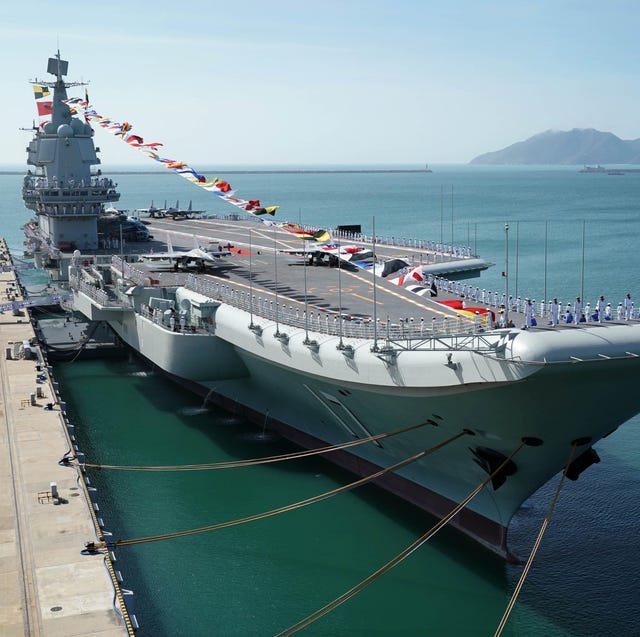
Only a handful of countries have aircraft carriers in their arsenals. They form an exclusive club of members that have decided their interests stretch so far from their own waters, they need to put air power at sea.
Broadly speaking, there are three aircraft carrier types today: larger carriers that carry both fixed-wing aircraft and helicopters; smaller carriers that operate helicopters; and amphibious ships that have full-length flight decks, hangars, and carry helicopters.
Some of the world's carriers are new, bristling with planes and capable of circumnavigating the globe without refueling. Others, meanwhile, are at least a half-century old and carry just a handful of obsolete planes, rarely leaving base.
Here's a comprehensive look at the world's fleet.
United States of America
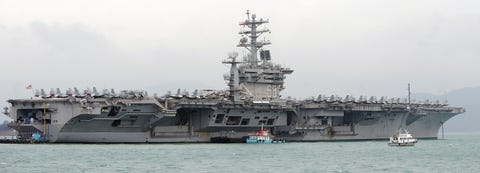
The United States now operates 10 Nimitz-class "supercarriers," aircraft carriers that dwarf all other flat-tops worldwide both in size and capability.
The Nimitz carriers are 1,092 feet long and weigh a whopping 101,600 tons—60 percent larger than their nearest counterparts, the Queen Elizabeth class. Each ship is propelled to speeds in excess of 30 knots by a pair of nuclear reactors, giving them nearly unlimited range. The ships are built with high-tensile steel for protection, with layers of Kevlar over vital spaces.
Each Nimitz typically carries an air wing consisting of 24 F/A-18C Hornets, 24 F/A-E/F Super Hornets, 4 to 5 E/A-18G Growler electronic warfare aircraft, 4 E-2D Hawkeye airborne early warning and control aircraft, 2 C-2 Greyhound transport aircraft, and 6 Seahawk helicopters.
In addition to the Nimitz-class, the U.S. Navy also operates nine landing helicopter dock ships of the Wasp and America classes. These ships are 843 feet long and displace roughly 40,000 tons. The ships are designed to carry air and land elements of a U.S. Marine corps landing force and have full-length, carrier-like flight decks.
Each ship can carry 10 MV-22 Osprey tiltrotor transports, 4 CH-53E heavy transport helicopters, 3 UH-1 Huey helicopters, 4 AH-1Z attack helicopters, and 6 AV-8B Harrier jump jets. With minimal modification, each Wasp can carry 24 Harriers.
The America class is optimized toward carrying Marine aviation units and can carry a few more Ospreys. In the near future, the F-35B Joint Strike Fighter will replace the Harriers on a 1:1 basis, and the America class will be capable of supporting up to 20 F-35Bs at once.
Several new supercarriers, USS Gerald R. Ford, USS John F. Kennedy, USS Enterprise, and USS Doris Miller—the first naval ship to be named after a Black sailor (and an enlisted sailor)—are under construction. An America-class ship, USS Tripoli, is also under development.
The age of supercarriers like the USS Gerald R. Ford may soon come to an end. Earlier this year, the acting Secretary of the Navy Thomas Modly told Defense & Aerospace Report the Navy may not purchase any more of this class of carrier.
China
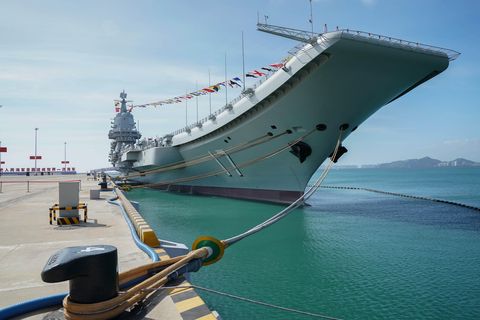
XINHUA NEWS AGENCYGETTY IMAGES
China has two aircraft carriers on deck. The first, the Liaoning, entered service in 2012. In 1998, a Chinese business man purchased the carrier from the Ukrainian government and announced he was going the ship into a floating casino. Instead, he promptly sold the vessel to the People's Liberation Army Navy (PLAN). Finally, after significant renovation, the Liaoning commissioned. (So far, the vessel has struggled in the fight against marauding jellyfish.)
In 2017, PLAN unveiled its first domestically built aircraft carrier, the Shandong. After nearly two years of sea trials, the vessel entered active service. It's been a busy year for the Shandong, which boasts almost 50,000 tons of displacement and is powered by a conventional propulsion system. Both the Liaoning and the Shandong have a key special feature: a ski-jump takeoff ramp designed to help fighter jets safely launch.
A third carrier, completely different in design from the PLAN's first two carriers, is currently under development. A rumored fourth carrier, this time powered by nuclear propulsion, may also be in the works. Both of these carriers are reportedly much larger than China's first two and will be equipped with an electromagnetic catapult designed to fling fighter jets into the air. (None of these vessels, it seems, will be able to fly.)
Russia
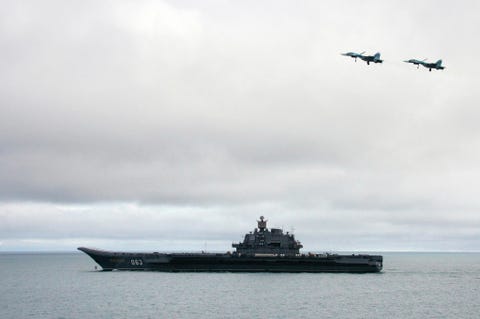
Russia has one aircraft carrier on active duty: the Admiral Kuznetsov. The carrier was built in what is now Ukraine, and after an extensive construction period complicated by the breakup of the Soviet Union, the ship was put into Russian service in 1991. Technically speaking, Kuznetsov is a sister ship of the Chinese carrier Liaoning.
Just over 1,000 feet long, Kuznetsov displaces 65,000 tons fully loaded. Her air wing consists of 18 Su-33 Flanker-D interceptors, 4 Su-25 Frogfoot attack jets, two Ka-31RLD airborne early warning and control helicopters, and 15 Ka-27PL anti-submarine warfare helicopters. Unlike other aircraft carriers, Kutznetsov also packs a punch in the form of 12 SS-N-19 Shipwreck supersonic anti-ship missiles and carries a naval version of the Tor surface-to-air missile for self-defense.
Admiral Kuznetsov isn't particularly mechanically reliable, having broken down at sea in 2012. Like most large Russian Navy ships, the carrier is accompanied by an oceangoing tug whenever it conducts an overseas cruise. You know, just in case. Admiral Kuznetsov has also had its fair share of bad luck lately. The aircraft carrier survived a number of crashes (including a shipyard accident in 2018) and a fire, which broke out last year.
Russia is planning to add to its fleet of one. The Russian Navy is reportedly surveying two possible designs to replace the Kuznetsov. Both designs, the ‘Shtorm’ and the ‘Lamantin,’ according to Forbes, have nuclear propulsion.
United Kingdom

The U.K. has two aircraft carriers currently under construction. There's the Queen Elizabeth, due to become operational in 2020, and Prince of Wales, due in 2022. They will be the largest ships ever built for the Royal Navy.
Once completed, the carriers will be 920 feet long and displace 65,000 tons apiece. Conventionally powered, they will operate both gas turbine and diesel engines. A high level of automation will keep the number of sailors manning each ship to just 679, with that number increasing to 1,600 with the air wing embedded.
Queen Elizabeth and Prince of Wales will feature a ski jump to assist jet takeoff instead of catapults. Each carrier will carry approximately 12 F-35 Joint Strike Fighters and 4 helicopters on peacetime cruises, with the capability to surge to 36 F-35s in wartime. Alternately, the ships can operate a mix of Apache, Merlin, Chinook, and Wildcat helicopters to land and support a Royal Marine landing force.
France
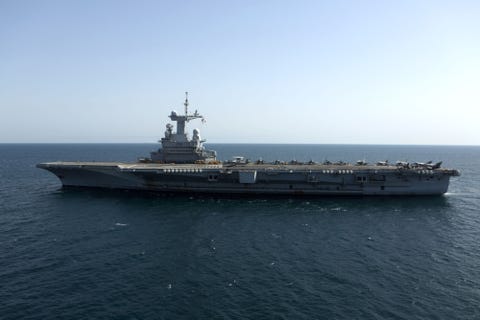
France has one working aircraft carrier, Charles de Gaulle. Commissioned in 2001, it measures 856 feet long and displaces 43,100 tons fully loaded. De Gaulle is the only nuclear-powered aircraft carrier in the world that's not part of the U.S. Navy. It has practically unlimited range.
The carrier typically supports an air wing consisting of 10 to 14 Rafale M multi-role fighters, 10 to 12 Super Etendard attack jets, two or three E-2C Hawkeye airborne early warning and control aircraft, and four to five search-and-rescue and transport helicopters. It's one of the few non-American carriers to have steam catapults to assist in takeoffs and arrestor wires to aid landings.
France is currently developing a 70,000-ton aircraft carrier, dubbed PANG, which it plans to unveil in 2038. Once it's ready, it will carry roughly 32 NGF fighter planes and a few E-2D Hawkeyes on board.
India

The first of India's two carriers, Viraat, is an ex-British light aircraft carrier that was until recently the flagship of the Indian Navy. Built during World War II, she is the oldest serving aircraft carrier in the world. Displacing 28,700 tons and 741 feet long, Viraat can carry nine Indian Navy Sea Harrier fighters and 15 Sea King, Helix, and Chetak helicopters.
The Indian Navy's new flagship is the carrier Vikramaditya (pictured). Formerly a Soviet ship used for anti-submarine warfare, Vikramaditya was fitted with an angled flight deck, given a 14-degree ski jump, and extensively modernized. Completed, she's 930 feet long and displaces 45,000 tons.
Vikramaditya has a powerful air wing consisting of 36 MiG-29K multi-role fighters—modernized versions of the MiG-29 optimized for carrier operations. She also embarks 12 Helix helicopters, both for airborne early warning and control and search-and-rescue operations.
A replacement for the Viraat, Vikrant, is currently under construction and will be India's first locally designed and built carrier. Indian Navy Chief Admiral Karambir Singh recently said he plans to make the case for a third aircraft carrier..
Japan
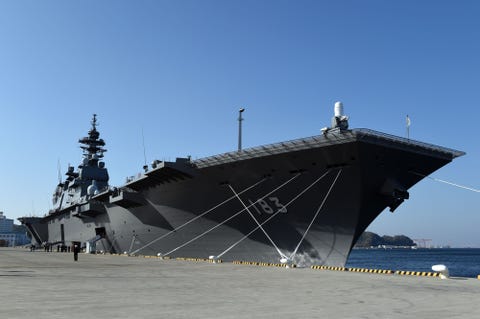
Once the world's preeminent aircraft carrier power, Japan has three of what it calls "helicopter destroyers"—aircraft carriers in all but name.
The country has two helicopter carriers of the Hyuga class. Coming in at 646 feet long and displacing 18,000 tons fully loaded, Hyuga and her sister ship Ise can handle tasks including anti-submarine warfare and amphibious assault. Each can embark up to 10 helicopters, including SH-60 anti-submarine helicopters, MCH-101 minehunters, AH-64 Apache attack helicopters, MV-22 Ospreys, and CH-47 transport choppers.
More recently, Japan launched the helicopter carrier Izumo (pictured). Approximately 30 percent larger than the older vessels, Izumo is 814 feet long and displaces 27,000 tons. A second ship in the class, Kaga, is currently fitting out.
Australia
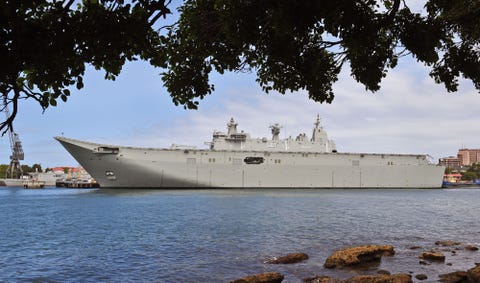
Australia has a long tradition of operating aircraft carriers, from seaplane carriers of the 1920s to the last full-deck Australian carrier, HMAS Melbourne, which retired in 1982. After a three-decade hiatus, the Canberra-class amphibious ships mark the return of Australian carrier aviation.
Technically amphibious ships, HMAS Canberra and her sister ship HMAS Adelaide (pictured) are each 757 feet long and displace 27,830 tons when fully loaded. Their hulls, built in Spain, are based on the Spanish Navy's Juan Carlos I-class amphibious ships.
The Canberra class is designed to carry amphibious troops, and to that end, the vessels have a full-length flight deck, hangar, and elevators to move aircraft back and forth between the two. Each can support up to 12 aircraft, including Australian Navy Sea King and Sea Hawk helicopters and Australian Army Tiger attack helicopters, MRH-90 transports, and CH-47 Chinook heavy transports.
The Juan Carlos-class was built to accommodate vertical takeoff and landing fighters. However, the Australian government has downplayed the possibility of F-35s operating from the decks of these twin carriers.
Italy
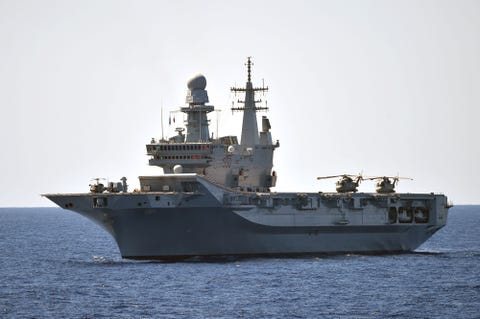
The Cavour (pictured) is one of a pair of Italian carriers; the other is the Giuseppe Garabaldi. Cavour is 774 feet long and displaces 27,100 tons, while the smaller Garabaldi is 590 feet long and displaces just 13,850 tons. Both are conventionally powered, using General Electric LM2500 gas turbine engines for propulsion.
Cavour and Garabaldi are equipped with Harrier fighters and helicopters. Both carriers can send 12 helicopters or 10 Harriers into action, but only Cavour features a 12-degree angle ski ramp to assist Harriers on takeoffs. Cavour will be modified to accommodate the Italian Navy's planned force of 15 F-35B Joint Strike Fighters.
South Korea
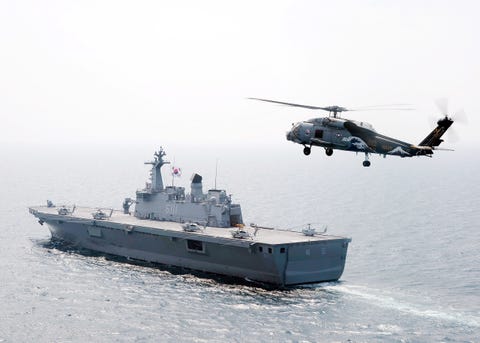
WIKIMEDIA COMMONS
The ROKS Dokdo is a an amphibious ship capable of launching air and naval assaults. Measuring 653 feet long and displacing 18,800 tons, Dokdo is the largest warship ever built for the Republic of Korea Navy.
ROKS Dokdo's full-length flight deck can handle up to five helicopters at once. She has a internal hangar bay just under the flight deck and two large elevators for shuttling helicopters back and forth. The ship can send up to 10 UH-60 Blackhawk troop-carrying helicopters into action at a time.
In addition to operating as a helicopter carrier, Dokdo can act as a command ship, too. South Korea is currently expanding its naval fleet. The country announced earlier this year that it's building its first official aircraft carrier—an LPX-II-class ship that will house 15 fighter jets.
Brazil
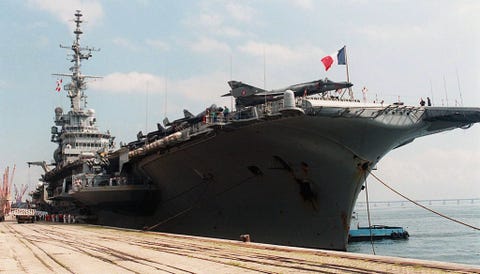
Brazil bought its sole aircraft carrier, Sào Paolo, used from France in 2000. Originally built in 1963, Sào Paolo is one of the oldest carriers in service and the only one operating in South America.
The ship is 869 feet long and displaces 33,000 tons fully loaded with aircraft, weapons, and fuel. In addition to steam catapults for launching planes, she also has retractable ski jumps to give launching planes an extra boost. Her air wing consists of 12 A-4 Skyhawks, older attack jets considered obsolete but recently upgraded by Brazilian aircraft manufacturer Embraer. She will also carry four C-1A Trader transport aircraft and an estimated 20 helicopters of various types.
Sào Paolo has been beset by mechanical issues since its transfer from the French Navy. Despite upgrades to its propulsion systems, the ship has suffered multiple onboard fires and reportedly can't handle voyages of longer than three months.
In 2018, Brazil officially retired its sole aircraft carrier and sent it to the scrapyard. The U. S. Navy is now the only naval power in the Western Hemisphere with aircraft carriers.
Spain

Named after the Spanish king who abdicated in 2014, Juan Carlos I is an amphibious ship with a dedicated aviation role. Measuring 754 feet long and displacing 27,082 tons when fully loaded, the ship can land nearly a thousand Spanish marines by air and sea.
Juan Carlos I has a full-length flight deck, too, plus a pair of elevators and hangar. It has a 12-degree ski jump for launching Sea Harrier jump jet fighters. The ship can carry up to 30 helicopters or 10 to 12 Sea Harriers, or some mixture of both.
The Spanish Navy's website states Juan Carlos I can carry the F-35B, the vertical takeoff and landing version of the Joint Strike Fighter, even though there are no official plans yet by the Spanish government to buy any of the jets.
Thailand
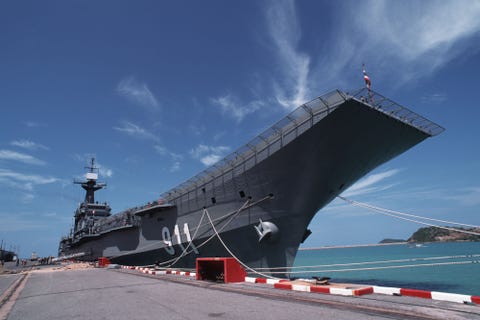
Thailand's carrier, the Chakri Naruebet, was named in honor of the Thai royal dynasty. This isn't just Southeast Asia's only carrier—it's also the only one with a royal suite built for a king.
Chakri Naruebet was constructed in a Spanish shipyard and based on Spain's Principe de Asturias (since retired). At 597 feet long and displacing 11,400 tons fully loaded, she's one of the smallest carriers around. Chakri Naruebet originally had an air wing of nine Harrier jets, but a lack of spare parts has permanently grounded the entire fleet. The working remainder of her air wing consists of 4 SH-60 Seahawk helicopters.
As a flat top, Chakri Naruebet is minimally operational. Budget cuts have resulted in the carrier operating outside of its naval base at Sattahip for only one day a month. Without its Harriers, the ship is more apt to carry the king and his entourage for royal cruises than to embark on military exercises, which has led to it being dubbed "The World's Largest Royal Yacht."
No comments:
Post a Comment